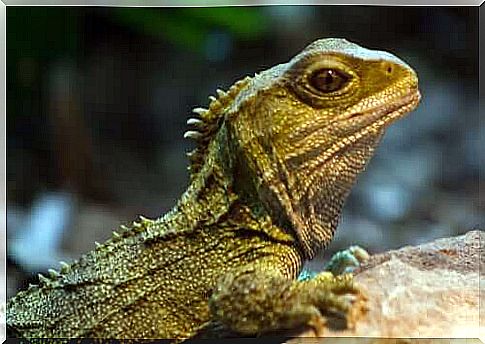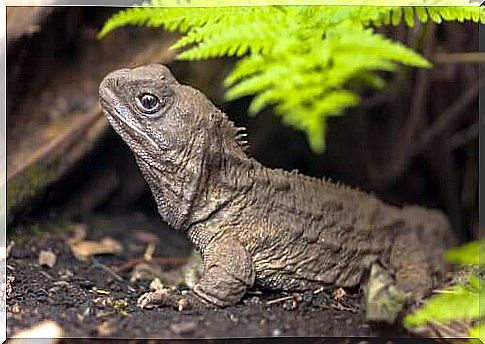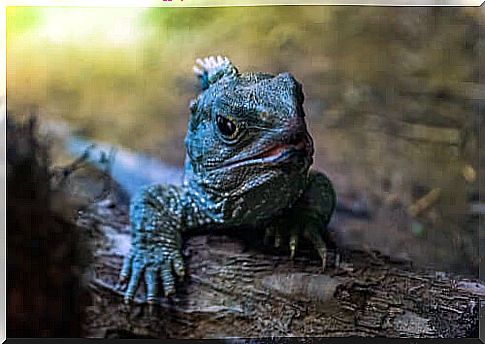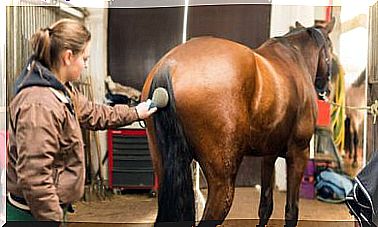The Bridge Lizard: Survival Artist From The Dinosaur Era

The bridge lizard is a reptile that belongs to the order Rhynchocephalia and is endemic to New Zealand. It resembles a lizard, but has characteristics typical of Tertiary reptiles. It dates from the Triassic period 200 million years ago.
Classification
The bridge lizard , also called tuatara, belongs to the order Rhynchocephalia. This order of the Diapsida reptiles is extremely old. It had its maximum spread in the Jura, only to become irrevocably extinct during the Cretaceous period.
About 60 million years ago, practically all but one species of this order disappeared. The species that still exists today is called Sphenodon puntactus , the New Zealand bridge lizard.
However, there is another species, Sphenodon guntheri , as well as a subspecies, Sphenodon puntactus . They can be distinguished because S. guntheri is significantly smaller than S. puntactus .
Features of the bridge lizard
This “living fossil” is mainly characterized by the thorny crest, which is less visible in female specimens. On the other hand, his large head has soft, wrinkled skin.
This species also lacks external ears. On the other hand, it can be observed that it has sturdy and well-developed limbs. In terms of size, it can grow to be 50 to 70 centimeters long and weigh anywhere from 0.5 to 1 kilo.
They are exceptionally long-lived animals with slow development. The females do not begin to reproduce until they are 20 years old. Once they have mated and laid their eggs, the young do not hatch for two years after fertilization.

Their life expectancy is estimated at up to 100 years. Hence, reproduction itself is a rather rare occurrence.
Habitat and diet of the bridge lizard
The two species and the subspecies are found in different geographic regions, more precisely in the two archipelagos along New Zealand:
- Sphenodon puntactus . The common bridge lizard can be found on the North Island of New Zealand.
- Sphenodon guntheri . It is located on the islands of the Cook Strait and was discovered in 1989.
They are land animals that prefer rocky terrain, especially rocky coasts. The peculiarity of this reptile is that it breathes slowly; In the resting phase, an hour can pass between one inhalation and the next.
They are nocturnal carnivorous and insectivorous animals: They have a varied diet and eat insects, snails, eggs, young birds or lizards. Occasionally cannibalism has been reported.
conservation
Bridge lizards are critically endangered animals. They were added to the Red List in 1996. Currently they are now than animals at lower risk (lower risk) classified.
The exact number of specimens of this genus is currently not known. However, it has been reported that the population is highly fragmented.

Among the measures that are part of the protection plan, the following can be highlighted:
- Creation of accommodation
- Use of frogs to help feed the reptiles
- Resettlement or control of mammals
- Resettlement in the national parks
The bridge lizard was threatened with extinction a few decades ago through human negligence, which meant the loss of part of its habitat. In addition, the introduction of new species such as rats and martens reduced the size of their habitat and food.
Curiosities of the bridge lizard
The bridge lizard was a contemporary of the dinosaurs about 240 million years ago. Although evolutionary convergence suggests that it is related to iguanas, these species are not really closely related in time.
To date, the function of the “third eye” or the “crown eye” the tuatara, which is located at the top of the skull, not clear. Inside, the parietal organ is protected by a layer of connective tissue.
It is believed to be photosensitive. There are studies to suggest that it traps infrared radiation that helps the lizard hunt.
The pineal gland usually has different functions depending on which group it is in. In reptiles it regulates body temperature, while in mammals it controls the duration of the day-night cycle. It also regulates seasonal behavior, such as wintering or the mating season.
Unlike other reptiles, bridge lizards like the cold. They are able to survive in hibernation at temperatures of 5 ° C. However, temperatures above 25 ° C are fatal for the bridge lizard.









